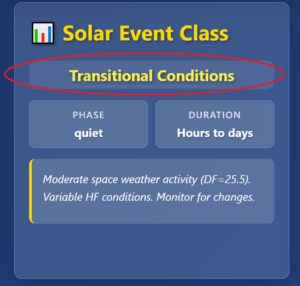How to spot brief propagation opportunities hidden within geomagnetic storms using tactical trend analysis
Most amateur radio operators see a geomagnetic stor
m warning and immediately write off HF operations for the next 24-48 hours. That’s a costly mistake. Even during major space weather events, there are brief windows of excellent propagation hidden within the chaos – you just need to know how to find them.
The secret is understanding that geomagnetic storms aren’t constant walls of disturbance. They’re dynamic events with peaks, valleys, and quiet interludes that create unexpected opportunities for skilled operators who know how to hunt for them.
The Storm Breathing Pattern: Why Disturbances Have Rhythms
Geomagnetic storms aren’t like thunderstorms – they don’t just “happen” and then stop. They have complex internal structures with predictable patterns that create tactical opportunities:
Storm Anatomy: The Three-Phase Pattern
- Onset Phase (1-6 hours): Rapid deterioration, avoid HF operations
- Main Phase (6-24 hours): Peak intensity with periodic quiet intervals
- Recovery Phase (12-72 hours): Gradual improvement with extended quiet periods
The opportunity: Phases 2 and 3 contain multiple quiet periods that often provide better propagation than normal conditions. While everyone else is off the air, you’re working rare DX.
High-Speed Stream Events: The Recurring Opportunity
Coronal hole streams create recurring disturbance patterns:
- 4-6 hour disturbance periods: High geomagnetic activity
- 2-4 hour quiet intervals: Normal or enhanced propagation
- Pattern repeats for 3-7 days: Multiple opportunities per event
SolarCdx.com’s correlation engine tracks these patterns in real-time, showing you exactly when the next quiet interval is likely to begin.
Finding the Windows: Tactical Trend Analysis
Traditional space weather monitoring shows you current conditions. Tactical propagation intelligence shows you where conditions are heading and when opportunities will occur.
The Delta H Trend Method
Monitor SolarCdx.com’s Delta H trend analysis for these key patterns:
Declining Delta H Slope:
- Delta H dropping from 8+ nT to 3-5 nT: Major opportunity developing
- Rate of decline >1.5 nT per hour: Strong recovery trend, high confidence
- Sustained decline for 2+ hours: Window likely to continue
Plateauing Delta H:
- Delta H stable at 2-4 nT for 1+ hours: Current quiet period established
- Low variability (<0.5 nT fluctuation): Stable conditions confirmed
- Duration indicates remaining window: Plan operations accordingly
Example from SolarCdx.com data: During a recent G3 geomagnetic storm, Delta H declined from 12.8 nT to 2.1 nT over 3.5 hours indicating that, for a small window, conditions were improving.
Operators monitoring the trend analysis caught a 6-hour window of excellent 20m propagation while everyone else stayed on 40m.
The Storm Phase Detection System
SolarCdx.com’s storm phase analysis identifies exactly where you are in the event cycle:

“Early Recovery” Phase:
- Storm intensity declining but still active
- 30-90 minute quiet periods beginning to appear
- Higher bands becoming intermittently usable
“Recovery” Phase:
- Clear trend toward quiet conditions
- 2-6 hour quiet periods with reliable propagation
- Excellent time for serious DX work
“Post-Storm” Phase:
- Storm completely subsided
- Ultra-quiet conditions often better than normal
- Prime time for weak signal work and contests
Multi-Parameter Confirmation: Avoiding False Signals
Single-parameter analysis creates false alarms. True quiet periods require multiple confirming indicators from SolarCdx.com’s correlation engine:
The Confirmation Checklist
✅ Delta H Trend: Declining or stable at low values
✅ Solar Wind Speed: Decreasing or normal (<500 km/s)
✅ Bz Component: Neutral or northward (>-3 nT)
✅ Correlation Engine Status: “Recovery” or “Quiet” classification

Example confirmation:
- Delta H: 3.2 nT and declining
- Solar wind: 420 km/s (down from 650 km/s)
- Bz: +2.1 nT (northward)
- SolarCdx.com status: “Recovery Phase – Bands Improving”
- Action: Pursue higher band DX aggressively
Red Flag Indicators: False Quiet Periods
❌ Southward Bz with quiet Delta H: Incoming disturbance (30-90 minutes)
❌ Rising solar wind speed: New storm phase beginning
❌ X-ray flare activity: D-layer absorption overriding geomagnetic quiet
Check SolarCdx.com’s multi-parameter display – when indicators conflict, wait for alignment or use lower bands.
Band-Specific Tactics: Maximizing Each Window
Different bands recover at different rates during quiet periods. Understanding the recovery sequence lets you maximize each opportunity:
The Recovery Hierarchy
- 40m and 80m: First to stabilize (geomagnetic noise clears)
- 30m: Quick recovery, often unaffected anyway
- 20m: Usually recovers within 1-2 hours of Delta H dropping below 5 nT
- 17m and 15m: Require Delta H <4 nT for reliable operation
- 12m and 10m: Last to recover, need Delta H <3 nT
Tactical Band Progression
Hour 1 of Quiet Period: Test 20m, use 30m/40m as backup
Hour 2-3: Push 17m and 15m if 20m is stable
Hour 4+: Try 12m and 10m for enhanced propagation
SolarCdx.com’s band-specific recommendations provide real-time scoring for each band based on current trend analysis and recovery predictions.
Contest Applications: The Competitive Edge
Contest operators who master quiet period hunting gain massive advantages over competitors who shut down during active conditions:
The Field Day Opportunity
Field Day often coincides with solar maximum storm periods. While most clubs struggle with poor conditions, prepared teams use quiet period intelligence:
- Monitor SolarCdx.com’s 24-hour trend forecast before the event
- Plan operating schedules around predicted quiet periods
- Achieve Class A scores during Class B conditions
Real-Time Hunting Techniques
The 30-Minute Rule
Check SolarCdx.com every 30 minutes during active periods:
- Delta H trend analysis: Is recovery beginning?
- Correlation engine status: Phase change detected?
- Band recommendations: Any improvements since last check?
Don’t wait for “all clear” – hunt for developing opportunities.
The Test QSO Method
During apparent quiet periods:
- Start with reliable band (40m/30m) to confirm baseline
- Test next higher band with known strong station
- If successful, move up the band plan
- Monitor for deterioration using real-time SolarCdx.com data
The Recovery Prediction Strategy
Use SolarCdx.com’s recovery time predictions:
- “20m is coming back”: Prepare antennas, alert DX friends
- “Extended quiet period predicted”: Plan serious operating session
- “Recovery rate declining”: Current window closing, adjust strategy
Advanced Techniques: Multi-Event Analysis
Experienced quiet period hunters track multiple storm events simultaneously:
The Event Overlap Opportunity
When multiple space weather events coincide:
- Old storm recovering + new flare: Solar flux enhanced, geomagnetic quiet
- High-speed stream + CME: Complex patterns with unexpected quiet periods
- Multiple coronal holes: Predictable recurring patterns
SolarCdx.com’s correlation engine analysis identifies these complex scenarios and provides tactical guidance for navigating multi-event conditions.
The Seasonal Factor
Equinox periods amplify both storms and quiet periods:
- Spring/Fall storms are more intense but recovery periods are enhanced
- Winter storms last longer but quiet periods are more stable
- Summer storms are briefer with rapid recovery periods
Tools and Technology: Beyond Basic Monitoring
SolarCdx.com’s Quiet Period Detection
- Real-time Delta H trend analysis with recovery rate calculations
- Storm phase identification with duration predictions
- Multi-parameter correlation preventing false signals
- Band-specific recovery timelines with confidence percentages
Mobile Monitoring Setup
For contest stations and DX operations:
- SolarCdx.com dashboard for real-time updates
- Alert system for significant trend changes
- Recovery prediction notifications for optimal timing
The Bottom Line: Hidden Opportunities Everywhere
Geomagnetic storms don’t eliminate DX opportunities – they hide them. While the majority of operators avoid HF during active conditions, skilled quiet period hunters work amazing DX with minimal competition.
The difference is tactical propagation intelligence: knowing when opportunities exist, how long they’ll last, and which bands to use during each phase.
Master the quiet period hunt with SolarCdx.com’s advanced trend analysis. Stop avoiding active conditions and start exploiting the hidden windows within them.
Because the best DX often happens when everyone else thinks it’s impossible.
Master quiet period hunting with advanced tactical propagation intelligence at SolarCdx.com. Monitor real-time Delta H trend analysis, storm phase detection, recovery time predictions, and band-specific recommendations. Turn active space weather from obstacle into opportunity.
73,
W2ADX


